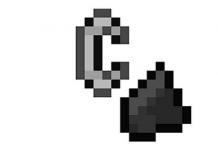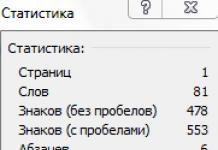To designate numbers in Latin, combinations of the following seven characters are accepted: I (1), V (5), X (10), L (50), C (100), D (500), M (1000).
To remember the letter designations of numbers in descending order, a mnemonic rule was invented:
M s D arim WITH face-to-face L imons, X vatit V seven I x (respectively M, D, C, L, X, V, I).
If the sign denoting a smaller number is to the right of the sign denoting a larger number, then the smaller number should be added to the larger one, if on the left, then subtract, namely:
VI - 6, i.e. 5+1
IV - 4, i.e. 5 - 1
XI - 11, i.e. 10 + 1
IX - 9, i.e. 10 - 1
LX - 60, i.e. 50 + 10
XL - 40, i.e. 50 - 10
CX - 110, i.e. 100 + 10
XC - 90, i.e. 100-10
MDCCCXII - 1812, i.e. 1000 + 500 + 100 + 100 + 100 + 10 + 1 + 1.
Different designations for the same number are possible. For example, the number 80 can be written as LXXX (50 + 10 + 10 + 10) and as XXX (100 - 20).
To write numbers in Roman numerals, you must first write the number of thousands, then hundreds, then tens, and finally units.
I (1) - unus (unus)
II (2) - duo (duo)
III (3) - tres (tres)
IV (4) - quattuor (quattuor)
V (5) - quinque
VI (6) - sex (sex)
VII (7) - septera (septem)
VIII (8) - octo (octo)
IX (9) - novem (novem)
X (10) - decem (decem)
XI (11) - undecim (undecim)
XII (12) - duodecim (duodecim)
ХШ (13) - tredecim (tradecim)
XIV (14) - quattuordecim (quattuordecim)
XV (15) - quindecim (quindecim)
XVI (16) - sedecim (sedecim)
XVII (17) - septendecim (septendecim)
XVIII (18) - duodeviginti (duodeviginti)
XIX (19) - undeviginti (undeviginti)
XX (20) - viginti (viginti)
XXI (21) - unus et viginti or viginti unus
XXII (22) - duo et viginti or viginti duo, etc.
XXVIII (28) - duodetriginta (duodetriginta)
XXIX (29) - undetriginta (undetriginta)
XXX (30) : triginta (triginta)
XL (40) - quadraginta (quadraginta)
L (5O) - quinquaginta (quinquaginta)
LX (60) - sexaginta (sexaginta)
LXX (70) - septuaginta (szltuaginta)
LXXX180) - octoginta (octoginta)
KS (90) - nonaginta (nonaginta)
C (100) centum (centum)
CC (200) - ducenti (ducenti)
CCC (300) - trecenti (trecenti)
CD (400) - quadrigenti (quadrigenti)
D (500) - quingenti (quingenti)
DC (600) - sescenti (sescenti) or sexonti (sextonti)
DCC (700) - septigenti (septigenti)
DCCC (800) - octingenti (octingenti)
CV (DCCC) (900) - nongenti (nongenti)
M (1000) - mille (mille)
MM (2000) - duo milia (duo milia)
V (5000) - quinque milla (quinque milia)
X (10,000) - decem milia (decem milia)
XX (20000) - viginti milia (viginti milia)
C (100000) - centum milia (centum milia)
XI (1,000,000) - decies centena milia (decies centena milia).
If suddenly an inquisitive person asks why the Latin letters V, L, C, D, M were chosen to denote the numbers 50, 100, 500 and 1000, then we will immediately say that these are not Latin letters at all, but completely different signs.
The fact is that the basis for the Latin alphabet was the Western Greek alphabet. It is to him that the three signs L, C and M go back. Here they denoted aspirated sounds, which were not in the Latin language. When the Latin alphabet was drawn up, they turned out to be superfluous. They were adapted to represent numbers in the Latin alphabet. Later they coincided in spelling with Latin letters. Thus, the sign C (100) became similar to the first letter of the Latin word centum (hundred), and M (1000) - to the first letter of the word mille (thousand). As for the sign D (500), it was half of the sign F (1000), and then it began to look like a Latin letter. The sign V (5) was just the upper half of the sign X (10).
That's the whole story with these Roman numerals.
Assignment to consolidate the material covered
Pay attention to the designation of three dates. Here the birth years of Alexander Pushkin, Alexander Herzen and Alexander Blok are encrypted in Roman numerals. Decide for yourself which Alexander belongs to which date.
MDCCCXH
MDCCXCIX
MDCCCLXXX
| 21st | XXI |
| 20th | XX |
| 19th | XIX |
| 18th | XVIII |
| 17th | XVII |
| 16th | XVI |
| 15th | XV |
| 14th | XIV |
| 13th | XIII |
| 12th | XII |
| 11th | XI |
| 10th | X |
| 9th | IX |
| 8th | VIII |
| 7th | VII |
| 6th | VI |
| 5th | V |
| 4th | IV |
| 3rd | III |
| 2nd | II |
| 1st | I |
Roman numerals, invented more than 2,500 years ago, were used by Europeans for two millennia before being replaced by Arabic numerals. This happened because Roman numerals are quite difficult to write, and any arithmetic operations in the Roman system are much more difficult to perform than in the Arabic number system. Despite the fact that the Roman system is not often used today, this does not mean that it has become irrelevant. In most cases, centuries are denoted in Roman numerals, but years or exact dates are usually written in Arabic numerals.
Roman numerals are also used when writing the serial numbers of monarchs, encyclopedic volumes, and the valency of various chemical elements. The dials of watches also often use Roman numerals.
Roman numerals are certain signs with which decimal places and their halves are written. For this purpose, only seven capital letters of the Latin alphabet are used. The number 1 corresponds to the Roman numeral I, 5 – V, 10 – X, 50 – L, 100 – C, 500 – D, 1000 – M. When denoting natural numbers, these numbers are repeated. So 2 can be written using two times I, that is, 2 – II, 3 - three letters I, that is, 3 – III. If a smaller digit comes before a larger one, then the principle of subtraction is used (the smaller digit is subtracted from the larger one). So, the number 4 is depicted as IV (that is, 5-1).
In the case when a larger number comes in front of a smaller one, they are added, for example, 6 is written in the Roman system as VI (that is, 5+1).
If you are used to writing numbers in Arabic numerals, then some difficulties may arise when you need to write centuries in Roman numerals, a number or a date. You can convert any number from the Arabic system to the Roman number system and vice versa very easily and very quickly using the convenient converter on our website.
On your computer keyboard, just switch to English to easily write any number in Roman numerals.
Apparently, the ancient Romans preferred straight lines, which is why all their numbers are straight and strict. However, Roman numerals are nothing more than a simplified image of the fingers of a human hand. The numbers one to four resemble outstretched fingers, the number five can be compared to an open palm with the thumb protruding. And the number ten resembles two crossed hands. In European countries, when counting, it is customary to straighten your fingers, but in Russia, on the contrary, bend them.
We all use Roman numerals - we use them to mark the numbers of centuries or months of the year. Roman numerals are found on clock dials, including the chimes of the Spasskaya Tower. We use them, but we don't know much about them.
How do Roman numerals work?
The Roman counting system in its modern version consists of the following basic signs:
I 1
V 5
X 10
L 50
C 100
D 500
M 1000
To remember numbers that are unusual for us who use the Arabic system, there are several special mnemonic phrases in Russian and English:
We Give Juicy Lemons, That's Enough
We Give Advice Only to Well-Educated Individuals
I Value Xylophones Like Cows Dig Milk
The system for arranging these numbers relative to each other is as follows: numbers up to three inclusive are formed by adding units (II, III) - repeating any number four times is prohibited. To form numbers greater than three, the larger and smaller digits are added or subtracted, for subtraction the smaller digit is placed before the larger one, for addition - after, (4 = IV), the same logic applies to other digits (90 = XC). The order of thousands, hundreds, tens and units is the same as what we are used to.
It is important that any number should not be repeated more than three times, so the longest number up to a thousand is 888 = DCCCLXXXVIII (500+100+100+100+50+10+10+10+5+1+1+1).

Alternative options

The ban on the fourth use of the same number in a row began to appear only in the 19th century. Therefore, in ancient texts one can see variants IIII and VIII instead of IV and IX, and even IIII or XXXXXX instead of V and LX. Remnants of this writing can be seen on the clock, where four is often marked with four units. In old books, there are also frequent cases of double subtractions - XIIX or IIXX instead of the standard XVIII.
Also in the Middle Ages, a new Roman numeral appeared - zero, which was denoted by the letter N (from the Latin nulla, zero). Large numbers were marked with special signs: 1000 - ↀ (or C|Ɔ), 5000 – ↁ (or |Ɔ), 10000 – ↂ (or CC|ƆƆ). Millions are obtained by double underlining standard numbers. Fractions were also written in Roman numerals: ounces were marked using symbols - 1/12, half was marked with the symbol S, and everything greater than 6/12 was marked with an addition: S = 10\12. Another option is S::.
Origin
At the moment there is no single theory of the origin of Roman numerals. One of the most popular hypotheses is that Etruscan-Roman numerals originated from a counting system that uses notched strokes instead of numbers.
Thus, the number “I” is not the Latin or more ancient letter “i”, but a notch reminiscent of the shape of this letter. Every fifth notch was marked with a bevel - V, and the tenth was crossed out - X. The number 10 in this count looked like this: IIIIΛIIIIX.
It is thanks to this recording of numbers in a row that we owe a special system of adding Roman numerals: over time, the recording of the number 8 (IIIIΛIII) could be reduced to ΛIII, which convincingly demonstrates how the Roman counting system acquired its specificity. Gradually, the notches turned into graphic symbols I, V and X, and acquired independence. Later they began to be identified with Roman letters - since they were similar in appearance to them.

An alternative theory belongs to Alfred Cooper, who suggested looking at the Roman counting system from a physiological point of view. Cooper believes that I, II, III, IIII is a graphical representation of the number of fingers of the right hand that the trader throws out when calling the price. V is the extended thumb, which together with the palm forms a figure similar to the letter V.

That is why Roman numerals add up not only ones, but also add them with fives - VI, VII, etc. - this is the thumb thrown back and the other fingers of the hand extended. The number 10 was expressed by crossing the hands or fingers, hence the symbol X. Another option was to simply double the number V, getting an X. Large numbers were transmitted using the left palm, which counted tens. So gradually the signs of ancient finger counting became pictograms, which then began to be identified with the letters of the Latin alphabet.
Modern Application
Today in Russia, Roman numerals are needed, first of all, to record the number of the century or millennium. It is convenient to place Roman numerals next to Arabic ones - if you write the century in Roman numerals, and then the year in Arabic, then your eyes will not be dazzled by the abundance of identical signs. Roman numerals have a certain connotation of archaism. They are also traditionally used to indicate the serial number of the monarch (Peter I), the volume number of a multi-volume publication, and sometimes the chapter of a book. Roman numerals are also used in antique watch dials. Important numbers, such as the year of the Olympiad or the number of a scientific law, can also be recorded using Roman numerals: World War II, Euclid's V postulate.
In different countries, Roman numerals are used slightly differently: in the USSR it was customary to indicate the month of the year using them (1.XI.65). In the West, the year number is often written in Roman numerals in the credits of films or on the facades of buildings.
In parts of Europe, especially in Lithuania, you can often find the days of the week designated in Roman numerals (I – Monday, and so on). In Holland, Roman numerals are sometimes used to denote floors. And in Italy they mark 100-meter sections of the route, marking, at the same time, every kilometer with Arabic numerals.
In Russia, when writing by hand, it is customary to emphasize the Roman numerals below and above at the same time. However, often in other countries, the underscore meant increasing the case of the number by 1000 times (or 10,000 times with a double underscore).
There is a common misconception that modern Western clothing sizes have some connection with Roman numerals. In fact, the designations are XXL, S, M, L, etc. have no connection with them: these are abbreviations of the English words eXtra (very), Small (small), Large (large).
In the process of life, we from time to time come across Roman numerals from 1 to 1000, once popular in the Roman Empire and the Middle Ages. They are used to indicate the number of centuries or millennia, blood type on military uniforms, the number of volumes in books, valency in a group of chemical elements, and much more. Having been popular at the beginning of our era, they gradually lost the palm, and are now used sporadically, under the influence of tradition or ceremony. What are the Roman numerals from 1 to 1000, what is their peculiarity, and why did they give way to their eastern, Arab-Indian competitors? Let's figure it out.
Roman numerals - genesis
Roman numerals (they are often mistakenly called “Latin”) are the development and heritage of Roman civilization. The ancient Romans created them to facilitate counting, in order to make it easier and more convenient to count various goods and services.
Roman numerals were widely used during the existence of a unified Roman state, as well as after its split into the Western and Eastern Roman Empire. Even after the fall of Constantinople, they continued to be used in various barbarian kingdoms until the end of the Middle Ages, until they gradually lost out to the Arab-Indian figures that dominate to this day.

Representation of Roman numerals from 1 to 1000
Roman numerals are represented by seven different letters - I, V, X, L, C, D and M, each of which represents a different number.

You can remember Roman numerals from 1 to 1000 using the following phrase (in descending order):

You may also be interested in our material on.
These seven letters are used to represent many different numbers, usually using summation. For example, the Roman numeral 2 is written as “II” (just two ones added together). The number 12 is like XII, that is, X+II. Well, number 27 is written as XXVII, that is, as a combination of XX + V + II.

Roman numerals were easily displayed with fingers
As you can see, Roman numerals are written starting from the largest digit and ending with the smallest, from left to right. However, that's not all. The Romans really did not like 4 numbers of the same type in a row, so they developed a special subtraction system.
In Roman numerals the number 3 is written as "III". However, the digit for the number 4 will not be “IIII”, since there are four symbols of the same type here, and the principle of subtraction must be used. In Roman numerals, the number 4 will be written as “IV”, that is, numbers 1 and 5. Since the smaller digit (1) comes before the larger one (5), we subtract the smaller digit from the larger digit and get 4. The same principle is used for the number "9", which in the Roman system is written as "IX" (1 and 10)
Here are six more similar examples that allow you to use Roman numerals from 1 to 1000:
- I can come before V (5) and X (10) creating the numbers 4 and 9.
- X can come before L (50) and C (100) creating the numbers 40 and 90.
- C can come before D (500) and M (1000) creating the numbers 400 and 900.
Number 1994 is an excellent example for this rule. In Roman numerals it looks like MCMXCIV, that is, M = 1000, CM = 900, XC = 90 and IV = 4.
Years and dates
To write the year in Roman numerals from 1 to 1000, we need large numbers. For example, we start the 2020 entry with MM (2000), add XX (20) and get MMXX.
Years from the 20th century are just as easy to obtain. We start with the number 1900 (MSM), to which we add the required number of years. For example, 1985 would look like MSM (1900) LXXX (80) + V (5) = MCMLXXXV.

Large Roman numerals
Since the digit M (1000) is the largest number in the Roman numeral system, and we can only use three identical symbols when creating a number, the maximum number represented in the Roman numeral system is 3999 (MMMCMXCIX). However, we can write large numbers, we just need to draw a top line over the numbers to multiply them by 1000.
For example, the Roman notation for the number 5000 (5*1000) is written as
1 million (1000*1000) is written as
Accordingly, 1,550,000 is written as
As you can see, everything is quite simple.
Table of Roman numerals from one to thousand
Below I have inserted a table of Arabic (Russian) numerals starting from 1 to 1000 and the corresponding Roman numerals.
Arabic numerals | Roman numerals |
|---|---|
Conclusion
The specification of Roman numerals involves the use of only seven letters, denoting round numbers from 1 to 1000. Despite their former widespread use, the principles of addition and subtraction of such numbers carry a number of inconveniences for the counter, as a result of which the Roman numeral system lost competition to the more advanced Arabic model. Nevertheless, we can find Roman numerals in sports, military, scientific and other fields, therefore it is important to know the features of their display and application.
Roman numerals are the numerals used by the ancient Romans in their non-positional number system.
Natural numbers are written by repeating these numbers: I (1), V (5), X (10), L (50), C (100), D (500), M (1000). Moreover, if a larger number is in front of a smaller one, then they are added (the principle of addition), but if a smaller one is in front of a larger one, then the smaller one is subtracted from the larger one (the principle of subtraction). The last rule applies only to avoid repeating the same number four times.
To correctly write large numbers in Roman numerals, you must first write the number of thousands, then hundreds, then tens, and finally units. In this case, some of the numbers (I, X, C, M) can be repeated, but no more than three times in a row; thus, they can be used to write any integer up to 3999 (MMMCMXCIX).
The smaller number can be written to the left of the larger one, then it should be subtracted from the larger one. In this case, only numbers denoting 1 or powers of 10 can be subtracted, and only the two digits closest in the number series to the subtrahend (that is, the subtrahend multiplied by 5 or 10) can be used as a minuend. Repetitions of a smaller number are not allowed. Thus there is only six options using the “subtraction rule”:
- IV = 4
- IX = 9
- XL=40
- XC = 90
- CD = 400
- CM = 900
Converting a number written in Roman numerals to a decimal number
Converting a Decimal Number to Roman Numerals
- Similar articles
Login using:
Random articles
- 20.09.2014
Simple logic chips of the 74 series are widespread in the world and are produced by many companies. Typically, the designation of these microcircuits contains a number of elements. For example, SN74BCT224D consists of five parts: the first two letters indicate the manufacturer: DM. Motorola, CD. Harris, M. M. Fairchild Semiconductor, National Semiconductor, SN. Texas Instruments, Philips...
- 29.09.2014
Transmitter characteristics: frequency range 27…28 MHz output power 0.5 W AF range 300…3000 Hz emission bandwidth 11 kHz frequency deviation at maximum modulation 2.5 kHz supply voltage 9 V current consumption 100 mA The signal from the microphone is sent to the direct input of op-amp DA1. A voltage divider R2R3 is connected at the input which creates half of it...


























